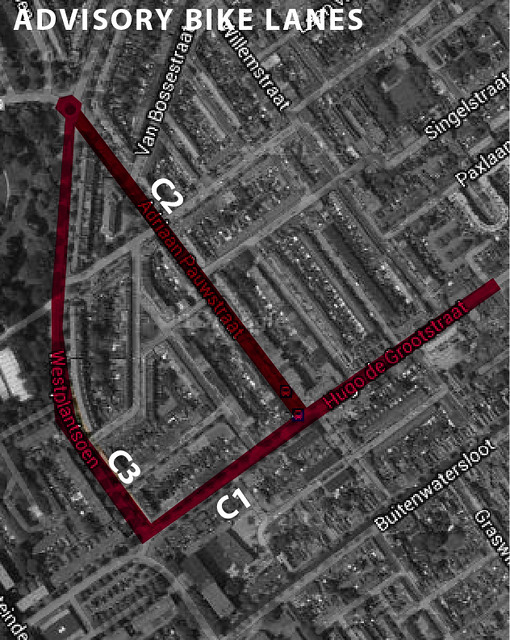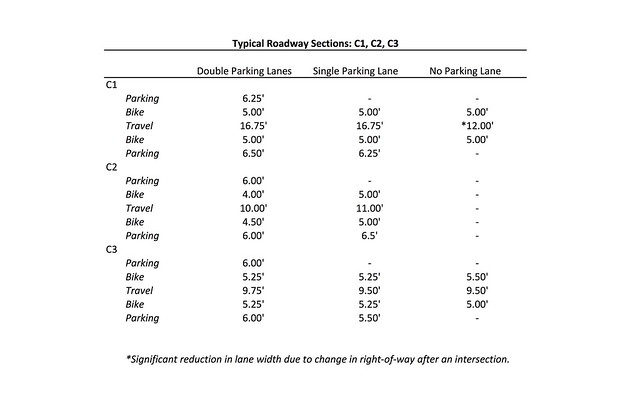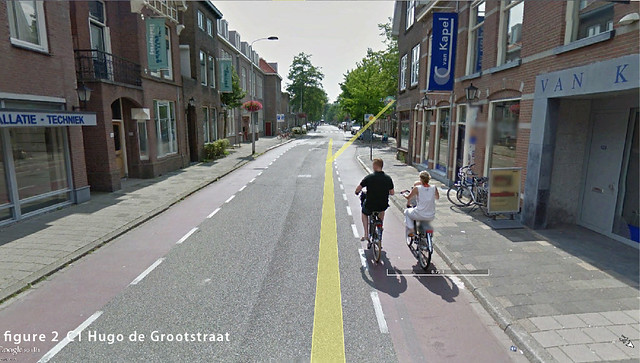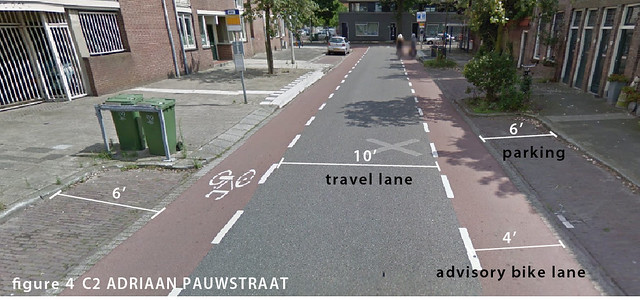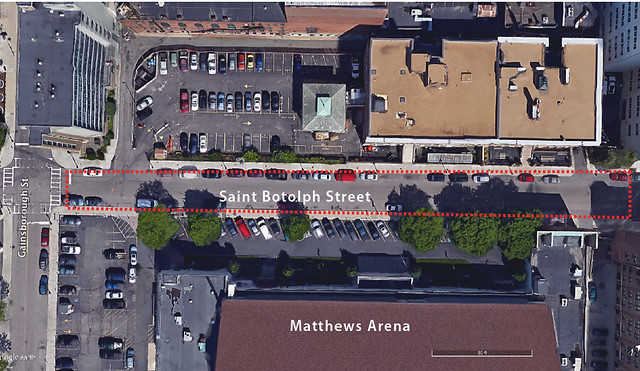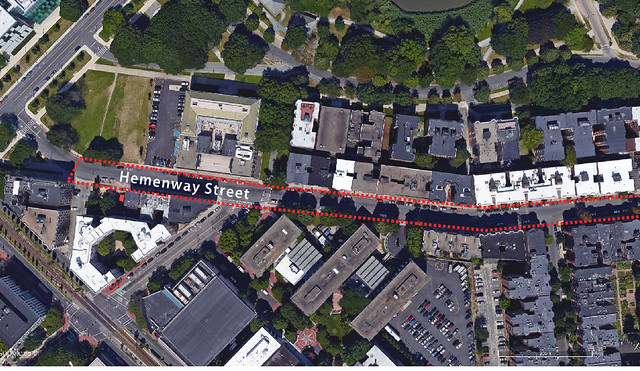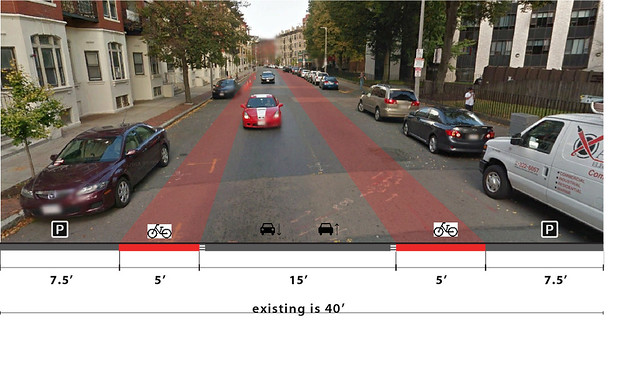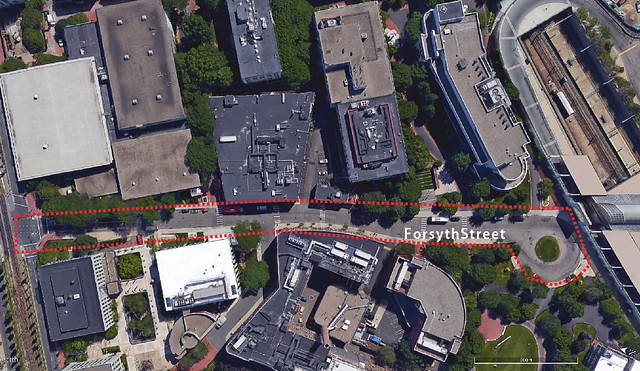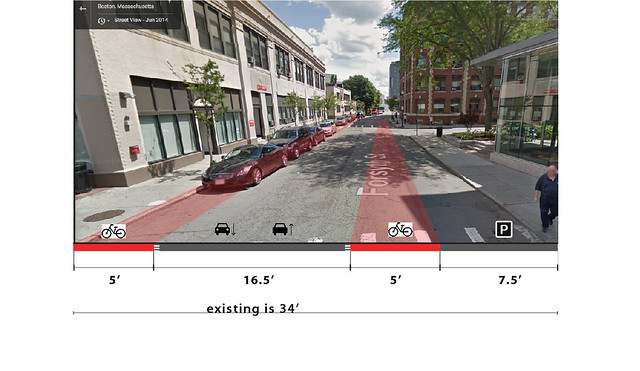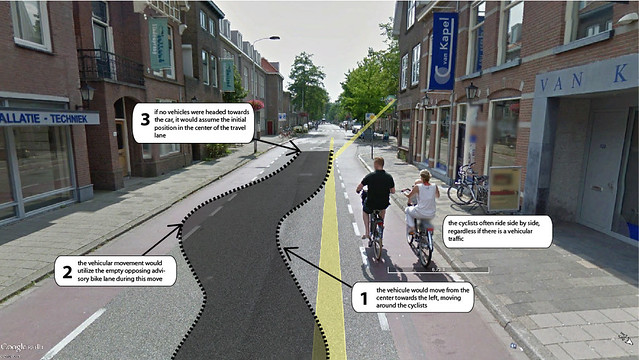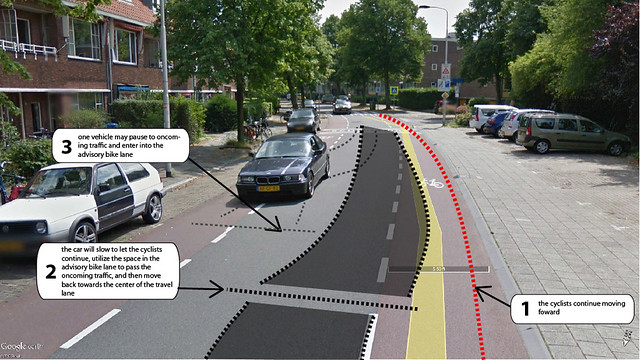Advisory Bike Lanes
Group 1: Tyler Wong, Molly McNally, Matt Duranleau, Caroline Lucas, Ryan Cullen, Vanessa Sandoval
[by Molly McNally and Ryan Cullen]
An advisory bike lane is an area designated for cyclists that vehicular motorists can share when conflicts occur, such as passing on-coming traffic. The temporarily shared space is delineated by a dashed line and red asphalt, suggesting that motorists can enter when necessary. This roadway design solution is implemented typically on narrow, unlaned streets where there is not enough space for fully separated travel lanes and bike lanes, and where traffic volume is more than a typical local street (which needs no special treatment for bikes), but is still low enough that it seems normal for a person to drive down the middle of the road.
How is it designed?
A street with advisory bike lanes utilizes colored asphalt paving and dashed white striping to mark bike lanes on either side of the road, leaving a black zone in the center that is not wide enough for two vehicles to pass. Parking lanes may be present on one or both sides and range from 6′ to 7′. Advisory bike lanes around 5′ in width border the inside of the parking lanes, and the remaining space in the center is left for cars. The vehicular zone expands on intersections approaches so that a stopped car in one direction won’t block entry from a car in the other direction. Otherwise, the passing vehicles must enter the advisory bike lane in order to continue down the street.
Typical cross-sections:
Data table:
Visuals C1:
Visuals C2:
Visuals C3:
Comparison of measurements:
Although parking lanes range slightly in size, they are typically designed in the interest of using as little space as possible – therefore we saw little variation in the size of parking lanes among the three streets using advisory bike lanes, usually around 6.0′ wide. There was also little variation among the bike lane widths, since the amount of space needed for a single rider is relatively standard and volumes did not necessarily require additional space. The variation in street width came with the significant adjustments in the width of the center vehicular zone, which varied from 9.5′ to 16.75′. Although all widths required passing cars to enter the advisory bike lanes, the possible passing arrangements and depth of bike lane intrusion by cars varied with the width of the center vehicular zone. There is likely a relationship between bike volume, car volume, and width of the vehicular zone, wherein both a wider central vehicular zone and lower bike volumes would allow for greater vehicle volumes because they would mean that bikes block the normal flow of traffic less.
Possible other implementations:
Looking to bring this design technique in the United States, we determined St. Botolph Street in Boston, MA to be a potential candidate for advisory bike lanes. See the locus map below.
It is worth considering which movements and behaviors of drivers and cyclists would be affected by adding advisory bike lanes. With the current design, a car overtaking a cyclist would simply remain in the center or even move into the opposite side of the street while the cyclist would maintain the original position along the parked cars. Adding the advisory bike lanes would not change this behavior, rather, it would legitimize and formalize the cyclist’s position in the street, making an otherwise uncomfortable position less stressful. Since the behavior of users is not drastically altered, this design improvement would cause no reduction in the existing capacity of the street, particularly since many users would not experience a conflict during off-peak hours.
St. Botolph Street at this location currently has a 34.35′ curb to curb width, serves two-way traffic , and has two parking lanes. Speed limit is 30 mph; based on the narrowness of the unmarked driving lane with parking on both sides and the frequent stop signs, vehicles likely drive below this speed. There is no existing lane striping.
The proposed cross section would include two 7.0′ parking lanes, two 5.0′ bike lanes, and a bi-directional 10.25′ vehicular zone. Refer to the following figures for design schematics. Also consider the position of the StreetView car, suggesting cars already drive in the center of the street.
Two additional street locations in Boston which may benefit from the incorporation of advisory bikes lanes are Hemenway Street and Forsyth Street. The following figures depict these locations.
Observations:
When cyclists rode in groups, they were typically seen riding side by side, often outside of the advisory bike lane an into the edge of the travel lane. If a car approached, the cyclist often would not move, rather, the car would simply go around. In another situation, cars in both directions were headed towards one another with a cyclist on one side. (Dutch law allows two cyclists to ride side by side.) The cyclist continued onward and one car would pause, pull over into the advisory lane, let the opposing car to drive forward, and then move back to the center and move forward. Therefore, in general, the cars were the ones to adjust their circulation while the cyclists continued with minor disruption. See the following diagrams depicting the movements of passing vehicles and bicycles.
